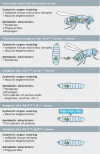Cancer cachexia: lessons from Drosophila
- PMID: 35319749
- PMCID: PMC8961677
- DOI: 10.1242/dmm.049298
Cancer cachexia: lessons from Drosophila
Abstract
Cachexia, a wasting syndrome that is often associated with cancer, is one of the primary causes of death in cancer patients. Cancer cachexia occurs largely due to systemic metabolic alterations stimulated by tumors. Despite the prevalence of cachexia, our understanding of how tumors interact with host tissues and how they affect metabolism is limited. Among the challenges of studying tumor-host tissue crosstalk are the complexity of cancer itself and our insufficient knowledge of the factors that tumors release into the blood. Drosophila is emerging as a powerful model in which to identify tumor-derived factors that influence systemic metabolism and tissue wasting. Strikingly, studies that are characterizing factors derived from different fly tumor cachexia models are identifying both common and distinct cachectic molecules, suggesting that cachexia is more than one disease and that fly models can help identify these differences. Here, we review what has been learned from studies of tumor-induced organ wasting in Drosophila and discuss the open questions.
Keywords: Drosophila; Cachectic factors; Cancer cachexia; Organ wasting.
© 2022. Published by The Company of Biologists Ltd.
Conflict of interest statement
Competing interests The authors declare no competing or financial interests.
Figures



Similar articles
-
Drosophila as a Model for Tumor-Induced Organ Wasting.Adv Exp Med Biol. 2019;1167:191-205. doi: 10.1007/978-3-030-23629-8_11. Adv Exp Med Biol. 2019. PMID: 31520356 Review.
-
Amiloride ameliorates muscle wasting in cancer cachexia through inhibiting tumor-derived exosome release.Skelet Muscle. 2021 Jul 6;11(1):17. doi: 10.1186/s13395-021-00274-5. Skelet Muscle. 2021. PMID: 34229732 Free PMC article.
-
Nonmuscle Tissues Contribution to Cancer Cachexia.Mediators Inflamm. 2015;2015:182872. doi: 10.1155/2015/182872. Epub 2015 Oct 7. Mediators Inflamm. 2015. PMID: 26523094 Free PMC article. Review.
-
MEF2c-Dependent Downregulation of Myocilin Mediates Cancer-Induced Muscle Wasting and Associates with Cachexia in Patients with Cancer.Cancer Res. 2020 May 1;80(9):1861-1874. doi: 10.1158/0008-5472.CAN-19-1558. Epub 2020 Mar 4. Cancer Res. 2020. PMID: 32132110 Free PMC article.
-
Skeletal muscle is enriched in hematopoietic stem cells and not inflammatory cells in cachectic mice.Neurol Res. 2008 Mar;30(2):160-9. doi: 10.1179/174313208X281046. Neurol Res. 2008. PMID: 18397608
Cited by
-
The roles of the native cell differentiation program aberrantly recapitulated in Drosophila intestinal tumors.Cell Rep. 2023 Oct 31;42(10):113245. doi: 10.1016/j.celrep.2023.113245. Epub 2023 Oct 12. Cell Rep. 2023. PMID: 37837622 Free PMC article.
-
Hepatic gluconeogenesis and PDK3 upregulation drive cancer cachexia in flies and mice.Nat Metab. 2025 Apr;7(4):823-841. doi: 10.1038/s42255-025-01265-2. Epub 2025 Apr 16. Nat Metab. 2025. PMID: 40275022 Free PMC article.
-
Translocation of gut bacteria promotes tumor-associated mortality by inducing immune-activated renal damage.EMBO J. 2025 Jul;44(13):3586-3613. doi: 10.1038/s44318-025-00458-5. Epub 2025 May 22. EMBO J. 2025. PMID: 40404992 Free PMC article.
-
Intratumor HIF-1α modulates production of a cachectic ligand to cause host wasting.Cell Insight. 2025 Apr 8;4(3):100247. doi: 10.1016/j.cellin.2025.100247. eCollection 2025 Jun. Cell Insight. 2025. PMID: 40336592 Free PMC article.
-
Metabolic Adaptations in Cancer and the Host Using Drosophila Models and Advanced Tools.Cells. 2024 Nov 29;13(23):1977. doi: 10.3390/cells13231977. Cells. 2024. PMID: 39682725 Free PMC article. Review.
References
Publication types
MeSH terms
Grants and funding
LinkOut - more resources
Full Text Sources
Medical
Molecular Biology Databases

